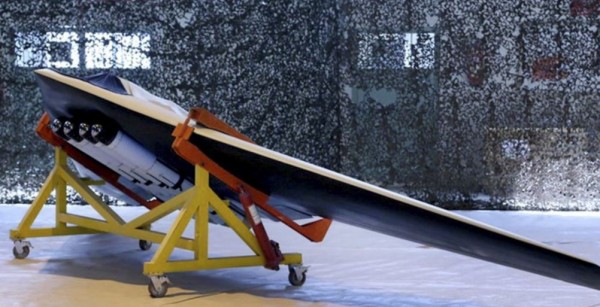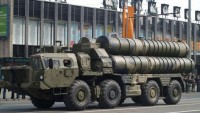Iran Reveals New UAV with Bombs Based on Captured US Drone
| Arthur Dominic Villasanta | | Oct 03, 2016 06:14 AM EDT |
(Photo : IRI) Iran's Saeqeh armed UAV.
Iran has unveiled a bomb-carrying military unmanned aerial vehicle (UAV) based on a U.S. drone that crashed into its territory in December 2011. This drone probably supplied intelligence that led to the death of Osama bin Laden.
Admitting it had reverse engineered the Lockheed Martin RQ-170 Sentinel UAV used mainly for high-altitude spying, Iran said its version called the "Saeqeh" (Thunderbolt) is armed with four smart bombs that can hit targets with "pinpoint accuracy."
Like Us on Facebook
Iran, however, has only revealed pictures of a static version of the Saeqeh propped up on supports and festooned with four bombs. It hasn't shown video of the UAV in flight or revealed any of its flight characteristics. This omission has led some western analysts to assume the static model is unflyable and it for propaganda purposes alone.
The RQ-170 Sentinel, which was introduced in 2007, is a stealth UAV operated by the U.S. Air Force (USAF) for the Central Intelligence Agency (CIA). The Sentinel, which isn't used for combat operations, is outfitted with reconnaissance equipment. The version lost over Iran was operated by the CIA.
Iran's semiofficial Tasnim news agency said the Saeqeh is a homegrown aircraft "made by reverse engineering the RQ-170. It said Saeqeh is part of a broad range of UAVs with civilian and military applications.
After Iran's capture of the drone, Iranian media said data recovered from the UAV showed it was used to spy on the Pakistan hideout of al-Qaida leader Osama bin Laden shortly before he was killed by U.S. forces in 2011.
The Iranian government first revealed to the public the first model of the Saeqeh in May 2014, saying it could be armed to attack U.S. Navy warships. Then, as now, Iran provided no proof this UAV could fly.
Iran said it captured the drone with minimal damage when one of its electronic warfare units managed to seize control of the UAV. The U.S. disputed this and said the probable cause was a glitch in the command-and-control system. How it fell from high altitude without being smashed to pieces hasn't been explained, however.
TagsIran, unmanned aerial vehicle, Saeqeh, Lockheed Martin RQ-170 Sentinel, CIA, osama bin laden
©2015 Chinatopix All rights reserved. Do not reproduce without permission
EDITOR'S PICKS
-

Did the Trump administration just announce plans for a trade war with ‘hostile’ China and Russia?
-

US Senate passes Taiwan travel bill slammed by China
-

As Yan Sihong’s family grieves, here are other Chinese students who went missing abroad. Some have never been found
-

Beijing blasts Western critics who ‘smear China’ with the term sharp power
-

China Envoy Seeks to Defuse Tensions With U.S. as a Trade War Brews
-

Singapore's Deputy PM Provides Bitcoin Vote of Confidence Amid China's Blanket Bans
-

China warns investors over risks in overseas virtual currency trading
-

Chinese government most trustworthy: survey
-

Kashima Antlers On Course For Back-To-Back Titles
MOST POPULAR
LATEST NEWS
Zhou Yongkang: China's Former Security Chief Sentenced to Life in Prison

China's former Chief of the Ministry of Public Security, Zhou Yongkang, has been given a life sentence after he was found guilty of abusing his office, bribery and deliberately ... Full Article
TRENDING STORY

China Pork Prices Expected to Stabilize As The Supplies Recover

Elephone P9000 Smartphone is now on Sale on Amazon India

There's a Big Chance Cliffhangers Won't Still Be Resolved When Grey's Anatomy Season 13 Returns

Supreme Court Ruled on Samsung vs Apple Dispute for Patent Infringement

Microsoft Surface Pro 5 Rumors and Release Date: What is the Latest?













